Two Decades of M-Commerce Consumer Research: A Bibliometric Analysis Using R Biblioshiny
Abstract
:1. Introduction
2. Methodology
2.1. Phase-I Document Selection
2.2. Phase-II Bibliometric Analysis
3. Results and Discussion
3.1. Performance Analysis
3.2. Evolutionary Analysis (Thematic Mapping)
3.2.1. Analysis of the Period 2001–2014
3.2.2. Analysis of the Period 2015–2018
3.2.3. Analysis of the Period 2019–2022
4. Conclusions
4.1. Summary of Performance Analysis
4.2. Summary of Evolutionary Analysis (Scientific Mapping)
4.3. Emerging Trends in M-Commerce Consumer Research
4.4. Limitations and Scope for Future Studies
Author Contributions
Funding
Institutional Review Board Statement
Informed Consent Statement
Data Availability Statement
Conflicts of Interest
References
- Statista. Number of Smartphone Subscriptions Worldwide from 2016 to 2021, with Forecasts from 2022 to 2027. 2022. Available online: https://www.statista.com/statistics/330695/number-of-smartphone-users-worldwide/ (accessed on 5 May 2023).
- Mehedintu, A.; Soava, G. A Hybrid SEM-Neural Network Modeling of Quality of M-Commerce Services under the Impact of the COVID-19 Pandemic. Electronics 2022, 11, 2499. [Google Scholar] [CrossRef]
- Kim, C.; Mirusmonov, M.; Lee, I. An empirical examination of factors influencing the intention to use mobile payment. Comput. Hum. Behav. 2010, 26, 310–322. [Google Scholar]
- Choi, S. What promotes smartphone-based mobile commerce? Mobile-specific and self-service characteristics. Internet Res. 2018, 28, 105–122. [Google Scholar] [CrossRef]
- Rodríguez-Torrico, P.; San-Martín, S.; José-Cabezudo, R.S. What Drives M-Shoppers to Continue Using Mobile Devices to Buy? J. Mark. Theory Pract. 2019, 27, 83–102. [Google Scholar] [CrossRef]
- Gupta, B.M.; Dhawam, S.M.; Gupta, R. Mobile commerce global publications: A quantitative and qualitative as-sessment during 2007–2016. DESIDOC J. Libr. Inf. Technol. 2018, 38, 179. [Google Scholar]
- Hew, J.-J.; Lee, V.-H.; Ooi, K.-B.; Wei, J. What catalyses mobile apps usage intention: An empirical analysis. Ind. Manag. Data Syst. 2015, 115, 1269–1291. [Google Scholar] [CrossRef]
- Baqeel, H.; Saeed, S. Face detection authentication on Smartphones: End Users Usability Assessment Experiences. In Proceedings of the 2019 International Conference on Computer and Information Sciences (ICCIS), Sakaka, Saudi Arabia, 3–4 April 2019; pp. 1–6. [Google Scholar] [CrossRef]
- Wang, R.J.-H.; Malthouse, E.C.; Krishnamurthi, L. On the Go: How Mobile Shopping Affects Customer Purchase Behavior. J. Retail. 2015, 91, 217–234. [Google Scholar] [CrossRef]
- Rise of Mcommerce: Mobile Ecommerce Shopping Stats & Trends in 2022. (15 April 2022). Insider Intelligence. Available online: https://www.insiderintelligence.com/insights/mobile-commerce-shopping-trends-stats/ (accessed on 9 May 2023).
- Chopdar, P.K.; Sivakumar, V.J. Understanding continuance usage of mobile shopping applications in India: The role of espoused cultural values and perceived risk. Behav. Inf. Technol. 2018, 38, 42–64. [Google Scholar] [CrossRef]
- Verma, D.; Tripathi, V.; Singh, A.P. From physical to digital: What drives generation Z for mobile commerce adoption? J. Asia Bus. Stud. 2021, 15, 732–747. [Google Scholar]
- Pandey, S.; Chawla, D. Engaging m-commerce adopters in India: Exploring the two ends of the adoption continuum across four m-commerce categories. J. Enterp. Inf. Manag. 2019, 32, 191–210. [Google Scholar]
- Yang, S.; Kwon, Y. Effects of mobile networks and COVID-19 on mobile shopping sales in South Korea. Telecommun. Policy 2022, 46, 102408. [Google Scholar]
- App Annie State of Mobile 2021. Data Ai. Available online: https://f.hubspotusercontent20.net/hubfs/8885028/App%20Annie%20-The%20State%20Of%20Mobile%202021%20.pdf (accessed on 21 March 2023).
- Hew, J.-J. Hall of fame for mobile commerce and its applications: A bibliometric evaluation of a decade and a half (2000–2015). Telemat. Inform. 2017, 34, 43–66. [Google Scholar] [CrossRef]
- Donthu, N.; Kumar, S.; Mukherjee, D.; Pandey, N.; Lim, W.M. How to conduct a bibliometric analysis: An overview and guidelines. J. Bus. Res. 2021, 133, 285–296. [Google Scholar] [CrossRef]
- Melcer, E.; Nguyen TH, D.; Chen, Z.; Canossa, A.; El-Nasr, M.S.; Isbister, K. Games research today: Analyzing the academic landscape 2000–2014. Network 2015, 17, 20. [Google Scholar]
- Moral-Muñoz, J.A.; Herrera-Viedma, E.; Santisteban-Espejo, A.; Cobo, M.J. Software tools for conducting biblio-metric analysis in science: An up-to-date review. Prof. Inf. 2020, 29, e290103. [Google Scholar]
- Muñoz-Leiva, F.; Viedma-del-Jesús, M.I.; Sánchez-Fernández, J.; López-Herrera, A.G. An application of co-word analysis and bibliometric maps for detecting the most highlighting themes in the consumer behaviour research from a longitudinal perspective. Qual. Quant. 2012, 46, 1077–1095. [Google Scholar]
- Gutiérrez-Salcedo, M.; Martínez, M.A.; Moral-Munoz, J.A.; Herrera-Viedma, E.; Cobo, M.J. Some bibliometric procedures for analyzing and evaluating research fields. Appl. Intell. 2017, 48, 1275–1287. [Google Scholar]
- Mumu, J.R.; Saona, P.; Mamun MA, A.; Azad MA, K. Is trust gender biased? A bibliometric review of trust in E-commerce. J. Internet Commer. 2022, 21, 217–245. [Google Scholar]
- Zerbini, C.; Aiolfi, S.; Bellini, S.; Luceri, B.; Vergura, D.T. Mobile shopping behavior: A bibliometric analysis. Sinergie Ital. J. Manag. 2022, 40, 233–256. [Google Scholar] [CrossRef]
- Huang, J.H.; Duan, X.Y.; He, F.F.; Wang, G.J.; Hu, X.Y. A historical review and Bibliometric analysis of research on Weak measurement research over the past decades based on Biblioshiny. arXiv 2021, arXiv:2108.11375. [Google Scholar]
- Veloutsou, C.; Liao, J. Mapping brand community research from 2001 to 2021: Assessing the field′s stage of devel-opment and a research agenda. Psychol. Mark. 2023, 40, 431–454. [Google Scholar]
- Mou, J.; Cui, Y.; Kurcz, K. Bibliometric and visualized analysis of research on major e-commerce journals using Citespace. J. Electron. Commer. Res. 2019, 20, 219–237. [Google Scholar]
- Zhu, J.; Liu, W. A tale of two databases: The use of Web of Science and Scopus in academic papers. Scientometrics 2020, 123, 321–335. [Google Scholar]
- Laudon, K.C.; Traver, C.G. E-Commerce 2017: Business. Technology. Society; Pearson: London, UK, 2017; Volume 13. [Google Scholar]
- Kim, H.-W.; Chan, H.C.; Gupta, S. Value-based Adoption of Mobile Internet: An empirical investigation. Decis. Support Syst. 2007, 43, 111–126. [Google Scholar] [CrossRef]
- Lin, H.H.; Wang, Y.S. An examination of the determinants of customer loyalty in mobile commerce contexts. Inf. Manag. 2006, 43, 271–282. [Google Scholar]
- Slade, E.L.; Dwivedi, Y.K.; Piercy, N.C.; Williams, M.D. Modeling Consumers’ Adoption Intentions of Remote Mobile Payments in the United Kingdom: Extending UTAUT with Innovativeness, Risk, and Trust. Psychol. Mark. 2015, 32, 860–873. [Google Scholar] [CrossRef] [Green Version]
- Wu, J.-H.; Wang, S.-C. What drives mobile commerce? An empirical evaluation of the revised technology acceptance model. Inf. Manag. 2005, 42, 719–729. [Google Scholar] [CrossRef]
- Cai, J.; Wohn, D.Y.; Mittal, A.; Sureshbabu, D. Utilitarian and hedonic motivations for live streaming shopping. In Proceedings of the 2018 ACM International Conference on Interactive Experiences for TV and Online Video, Seoul, Republic of Korea, 26–28 June 2018; pp. 81–88. [Google Scholar]
- Chan, X.Y.; Rahman, M.K.; Mamun, A.A.; ASalameh, A.; Wan Hussain WM, H.; Alam, S.S. Predicting the intention and adoption of mobile shopping during the COVID-19 lockdown in Malaysia. Sage Open 2022, 12, 21582440221095012. [Google Scholar] [CrossRef]
- Chong, A.Y.-L. Mobile commerce usage activities: The roles of demographic and motivation variables. Technol. Forecast. Soc. Chang. 2013, 80, 1350–1359. [Google Scholar] [CrossRef]
- Gan, C.; Wang, W. The influence of perceived value on purchase intention in social commerce context. Internet Res. 2017, 27, 772–785. [Google Scholar] [CrossRef]
- Kalinić, Z.; Marinković, V.; Djordjevic, A.; Liebana-Cabanillas, F. What drives customer satisfaction and word of mouth in mobile commerce services? A UTAUT2-based analytical approach. J. Enterp. Inf. Manag. 2019, 33, 71–94. [Google Scholar] [CrossRef]
- Gao, L.; Waechter, K.A.; Bai, X. Understanding consumers’ continuance intention towards mobile purchase: A theoretical framework and empirical study—A case of China. Comput. Hum. Behav. 2015, 53, 249–262. [Google Scholar] [CrossRef]
- Jimenez, N.; San-Martin, S.; Azuela, J.I. Trust and satisfaction: The keys to client loyalty in mobile commerce. Acad. Rev. Latinoam. Adm. 2016, 29, 486–510. [Google Scholar] [CrossRef]
- Dholakia, R.R.; Dholakia, N. Mobility and markets: Emerging outlines of m-commerce. J. Bus. Res. 2002, 57, 1391–1396. [Google Scholar] [CrossRef]
- Frolick, M.N.; Chen, L.-D. Assessing M-Commerce Opportunities. Inf. Syst. Manag. 2004, 21, 53–61. [Google Scholar] [CrossRef]
- Lee, E.; Jin, J. A next generation intelligent mobile commerce system. In Proceedings of the Software Engineering Research and Applications: First International Conference, SERA 2003, San Francisco, CA, USA, 25–27 June 2003; Selected Revised Papers 1. Springer: Berlin/Heidelberg, Germany, 2004; pp. 320–331. [Google Scholar]
- Mollick, J.; Cutshall, R.; Changchit, C.; Pham, L. Contemporary Mobile Commerce: Determinants of Its Adoption. J. Theor. Appl. Electron. Commer. Res. 2023, 18, 501–523. [Google Scholar]
- Kipper, L.M.; Furstenau, L.B.; Hoppe, D.; Frozza, R.; Iepsen, S. Scopus scientific mapping production in industry 4.0 (2011–2018): A bibliometric analysis. Int. J. Prod. Res. 2019, 58, 1605–1627. [Google Scholar] [CrossRef]
- Luarn, P.; Lin, H.-H. Toward an understanding of the behavioral intention to use mobile banking. Comput. Hum. Behav. 2005, 21, 873–891. [Google Scholar] [CrossRef]
- Bruner, G.C., II; Kumar, A. Explaining consumer acceptance of handheld Internet devices. J. Bus. Res. 2005, 58, 553–558. [Google Scholar]
- Lin, J.; Lu, Y.; Wang, B.; Wei, K.K. The role of inter-channel trust transfer in establishing mobile commerce trust. Electron. Commer. Res. Appl. 2011, 10, 615–625. [Google Scholar] [CrossRef]
- Cyr, D.; Head, M.; Ivanov, A. Design aesthetics leading to m-loyalty in mobile commerce. Inf. Manag. 2006, 43, 950–963. [Google Scholar]
- Parasuraman, A.; Colby, C.L. An updated and streamlined technology readiness index: TRI 2.0. J. Serv. Res. 2015, 18, 59–74. [Google Scholar]
- Kim, G.; Shin, B.; Lee, H.G. Understanding dynamics between initial trust and usage intentions of mobile banking. Inf. Syst. J. 2009, 19, 283–311. [Google Scholar]
- Cobo, M.J.; López-Herrera, A.G.; Herrera-Viedma, E.; Herrera, F. An approach for detecting, quantifying, and visualizing the evolution of a research field: A practical application to the Fuzzy Sets Theory field. J. Informetr. 2011, 5, 146–166. [Google Scholar] [CrossRef]
- Villa, E.; Ruiz, L.; Valencia, A.; Picón, E. Electronic Commerce: Factors Involved in its Adoption from a Bibliometric Analysis. J. Theor. Appl. Electron. Commer. Res. 2018, 13, 39–70. [Google Scholar] [CrossRef] [Green Version]
- Balasubramanian, S.; Peterson, R.A.; Jarvenpaa, S.L. Exploring the Implications of M-Commerce for Markets and Marketing. J. Acad. Mark. Sci. 2002, 30, 348–361. [Google Scholar] [CrossRef]
- Jih WJ, K.; Lee, S.F. An exploratory analysis of relationships between cellular phone uses’ shopping motivators and lifestyle indicators. J. Comput. Inf. Syst. 2004, 44, 65–73. [Google Scholar]
- Li, W.; McQueen, R.J. Barriers to mobile commerce adoption: An analysis framework for a country-level perspective. Int. J. Mob. Commun. 2008, 6, 231–257. [Google Scholar]
- Zhou, T. Examining the critical success factors of mobile website adoption. Online Inf. Rev. 2011, 35, 636–652. [Google Scholar] [CrossRef]
- Zhou, T.; Lu, Y. The Effects of Personality Traits on User Acceptance of Mobile Commerce. Int. J. Hum.-Comput. Interact. 2011, 27, 545–561. [Google Scholar] [CrossRef]
- Chong, A.Y.L. Understanding mobile commerce continuance intentions: An empirical analysis of Chinese consumers. J. Comput. Inf. Syst. 2013, 53, 22–30. [Google Scholar]
- Kao, D.T. The impact of transaction trust on consumers′ intentions to adopt M-commerce: A cross-cultural investigation. CyberPsychol. Behav. 2009, 12, 225–229. [Google Scholar]
- Yeh, Y.S.; Li, Y. Building trust in m-commerce: Contributions from quality and satisfaction. Online Inf. Rev. 2009, 33, 1066–1086. [Google Scholar] [CrossRef] [Green Version]
- Siau, K.; Shen, Z. Building customer trust in mobile commerce. Commun. ACM 2003, 46, 91–94. [Google Scholar] [CrossRef]
- Lin, J.; Wang, B.; Wang, N.; Lu, Y. Understanding the evolution of consumer trust in mobile commerce: A longitudinal study. Inf. Technol. Manag. 2013, 15, 37–49. [Google Scholar] [CrossRef]
- Bao, H.; Chong, A.Y.L.; Ooi, K.B.; Lin, B. Are Chinese consumers ready to adopt mobile smart home? An empirical analysis. Int. J. Mob. Commun. 2014, 12, 496. [Google Scholar] [CrossRef]
- Chong, A.Y.-L.; Chan, F.T.; Ooi, K.-B. Predicting consumer decisions to adopt mobile commerce: Cross country empirical examination between China and Malaysia. Decis. Support Syst. 2011, 53, 34–43. [Google Scholar] [CrossRef]
- Dai, H.; Palvi, P.C. Mobile commerce adoption in China and the United States: A cross-cultural study. ACM SIGMIS Database DATABASE Adv. Inf. Syst. 2009, 40, 43–61. [Google Scholar]
- Min, Q.; Ji, S. A meta-analysis of Mobile Commerce Research in China (2002–2006). Int. J. Mob. Commun. 2008, 6, 390. [Google Scholar] [CrossRef]
- Xu, D.J. The influence of personalization in affecting consumer attitudes toward mobile advertising in China. J. Comput. Inf. Syst. 2006, 47, 9–19. [Google Scholar]
- Publications Output. U.S. Trends and International Comparisons. (2021, October). National Science Board. Available online: https://ncses.nsf.gov/pubs/nsb20214 (accessed on 28 April 2023).
- Venkatesh, V.; Morris, M.G.; Davis, G.B.; Davis, F.D. User acceptance of information technology: Toward a unified view. MIS Q. 2003, 27, 425–478. [Google Scholar]
- Jebarajakirthy, C.; Maseeh, H.I.; Morshed, Z.; Shankar, A.; Arli, D.; Pentecost, R. Mobile advertising: A systematic literature review and future research agenda. Int. J. Consum. Stud. 2021, 45, 1258–1291. [Google Scholar] [CrossRef]
- Carroll, A.; Barnes, S.J.; Scornavacca, E.; Fletcher, K. Consumer perceptions and attitudes towards SMS advertising: Recent evidence from New Zealand. Int. J. Advert. 2007, 26, 79–98. [Google Scholar] [CrossRef]
- Benou, P.; Vassilakis, C.; Vrechopoulos, A. Context management for m-commerce applications: Determinants, methodology and the role of marketing. Inf. Technol. Manag. 2012, 13, 91–111. [Google Scholar] [CrossRef]
- Hwang, S.; Kim, S. Does mIM experience affect satisfaction with and loyalty toward O2O services? Comput. Hum. Behav. 2018, 82, 70–80. [Google Scholar] [CrossRef]
- Ozturk, A.B.; Bilgihan, A.; Nusair, K.; Okumus, F. What keeps the mobile hotel booking users loyal? Investigating the roles of self-efficacy, compatibility, perceived ease of use, and perceived convenience. Int. J. Inf. Manag. 2016, 36, 1350–1359. [Google Scholar] [CrossRef]
- Williams, M.D. Social commerce and the mobile platform: Payment and security perceptions of potential users. Comput. Hum. Behav. 2021, 115, 105557. [Google Scholar]
- Leong, L.Y.; Jaafar, N.I.; Sulaiman, A. What triggers impulse purchase in Facebook commerce? Int. J. Mob. Commun. 2018, 16, 459–492. [Google Scholar]
- Groß, M. Impediments to mobile shopping continued usage intention: A trust-risk-relationship. J. Retail. Consum. Serv. 2016, 33, 109–119. [Google Scholar] [CrossRef]
- Discover How Malaysia Is Becoming a Destination for Research Excellence. (2022, October 20). ELSEVIER. Available online: https://www.elsevier.com/research-intelligence/resource-library/malaysia-research-report (accessed on 13 April 2023).
- Teo, A.C.; Tan, G.W.H.; Ooi, K.B.; Lin, B. Why consumers adopt mobile payment? A partial least squares structural equation modelling (PLS-SEM) approach. Int. J. Mob. Commun. 2015, 13, 478. [Google Scholar] [CrossRef]
- Al-Saedi, K.; Al-Emran, M.; Ramayah, T.; Abusham, E. Developing a general extended UTAUT model for M-payment adoption. Technol. Soc. 2020, 62, 101293. [Google Scholar] [CrossRef]
- Chopdar, P.K.; Paul, J.; Prodanova, J. Mobile shoppers’ response to Covid-19 phobia, pessimism and smartphone addiction: Does social influence matter? Technol. Forecast. Soc. Chang. 2022, 174, 121249. [Google Scholar] [CrossRef]
- Shaw, N.; Sergueeva, K. The non-monetary benefits of mobile commerce: Extending UTAUT2 with perceived value. Int. J. Inf. Manag. 2019, 45, 44–55. [Google Scholar]
- Kim (Sunny), J. An extended technology acceptance model in behavioral intention toward hotel tablet apps with moderating effects of gender and age. Int. J. Contemp. Hosp. Manag. 2016, 28, 1535–1553. [Google Scholar] [CrossRef]
- Lee, Y.H.; Hsieh, Y.C.; Hsu, C.N. Adding innovation diffusion theory to the technology acceptance model: Supporting employees’ intentions to use e-learning systems. J. Educ. Technol. Soc. 2011, 14, 124–137. [Google Scholar]
- Morosan, C.; DeFranco, A. When tradition meets the new technology: An examination of the antecedents of attitudes and intentions to use mobile devices in private clubs. Int. J. Hosp. Manag. 2014, 42, 126–136. [Google Scholar] [CrossRef]
- Kwateng, K.O.; Atiemo, K.A.O.; Appiah, C. Acceptance and use of mobile banking: An application of UTAUT2. J. Enterp. Inf. Manag. 2019, 32, 118–151. [Google Scholar] [CrossRef]
- Van Droogenbroeck, E.; Van Hove, L. Adoption and Usage of E-Grocery Shopping: A Context-Specific UTAUT2 Model. Sustainability 2021, 13, 4144. [Google Scholar] [CrossRef]
- Loh, X.M.; Lee, V.H.; Tan GW, H.; Ooi, K.B.; Dwivedi, Y.K. Switching from cash to mobile payment: What’s the hold-up? Internet Res. 2020, 31, 376–399. [Google Scholar]
- Solarz, M.; Swacha-Lech, M. Determinants of the Adoption of Innovative Fintech Services by Millennials. E+M Èkon. A Manag. 2021, 24, 149–166. [Google Scholar] [CrossRef]
- Rialti, R.; Filieri, R.; Zollo, L.; Bazi, S.; Ciappei, C. Assessing the relationship between gamified advertising and in-app purchases: A consumers’ benefits-based perspective. Int. J. Advert. 2022, 41, 868–891. [Google Scholar] [CrossRef]
- Cimperman, M.; Brenčič, M.M.; Trkman, P. Analyzing older users’ home telehealth services acceptance behavior—Applying an Extended UTAUT model. Int. J. Med. Inform. 2016, 90, 22–31. [Google Scholar]
- Marinković, V.; Đorđević, A.; Kalinić, Z. The moderating effects of gender on customer satisfaction and continuance intention in mobile commerce: A UTAUT-based perspective. Technol. Anal. Strat. Manag. 2019, 32, 306–318. [Google Scholar] [CrossRef]
- Venkatesh, V.; Ramesh, V.; Massey, A.P. Understanding usability in mobile commerce. Commun. ACM 2003, 46, 53–56. [Google Scholar] [CrossRef]
- Venkatesh, V.; Thong, J.Y.; Xu, X. Consumer acceptance and use of information technology: Extending the unified theory of acceptance and use of technology. MIS Q. 2012, 36, 157–178. [Google Scholar]
- Schaeffer, K. (5 October 2021). 7 Facts about Americans and Instagram. Pew Research Center. Available online: https://www.pewresearch.org/fact-tank/2021/10/07/7-facts-about-americans-and-instagram/ (accessed on 15 March 2023).
- Narang, U.; Shankar, V. Mobile Marketing 2.0: State of the Art and Research Agenda; Emerald Insight: Bingley, UK, 2019; pp. 97–119. [Google Scholar] [CrossRef]
- Shin, W.; Lwin, M.O.; Yee, A.Z.H.; Kee, K.M. The role of socialization agents in adolescents’ responses to app-based mobile advertising. Int. J. Advert. 2019, 39, 365–386. [Google Scholar] [CrossRef]
- Quach, S.; Barari, M.; Moudrý, D.V.; Quach, K. Service integration in omnichannel retailing and its impact on customer experience. J. Retail. Consum. Serv. 2022, 65, 102267. [Google Scholar] [CrossRef]
- Bollaert, H.; Lopez-De-Silanes, F.; Schwienbacher, A. Fintech and access to finance. J. Corp. Finance 2021, 68, 101941. [Google Scholar] [CrossRef]
- Chen, C.-C.; Lin, Y.-C. What drives live-stream usage intention? The perspectives of flow, entertainment, social interaction, and endorsement. Telemat. Inform. 2018, 35, 293–303. [Google Scholar] [CrossRef]
- Chen, J.; Liao, J. Antecedents of Viewers’ Live Streaming Watching: A Perspective of Social Presence Theory. Front. Psychol. 2022, 13, 839629. [Google Scholar] [CrossRef]
- Zhang, M.; Liu, Y.; Wang, Y.; Zhao, L. How to retain customers: Understanding the role of trust in live streaming commerce with a socio-technical perspective. Comput. Hum. Behav. 2021, 127, 107052. [Google Scholar] [CrossRef]
- Liao, J.; Chen, K.; Qi, J.; Li, J.; Yu, I.Y. Creating immersive and parasocial live shopping experience for viewers: The role of streamers’ interactional communication style. J. Res. Interact. Mark. 2022, 17, 140–155. [Google Scholar] [CrossRef]
- Wongkitrungrueng, A.; Assarut, N. The role of live streaming in building consumer trust and engagement with social commerce sellers. J. Bus. Res. 2018, 117, 543–556. [Google Scholar] [CrossRef]
- Xu, X.; Wu, J.H.; Li, Q. What drives consumer shopping behavior in live streaming commerce? J. Electron. Commer. Res. 2020, 21, 144–167. [Google Scholar]
- Zheng, S.; Chen, J.; Liao, J.; Hu, H.-L. What motivates users’ viewing and purchasing behavior motivations in live streaming: A stream-streamer-viewer perspective. J. Retail. Consum. Serv. 2023, 72, 103240. [Google Scholar] [CrossRef]
- Mukherjee, D.; Lim, W.M.; Kumar, S.; Donthu, N. Guidelines for advancing theory and practice through bibliometric research. J. Bus. Res. 2022, 148, 101–115. [Google Scholar] [CrossRef]
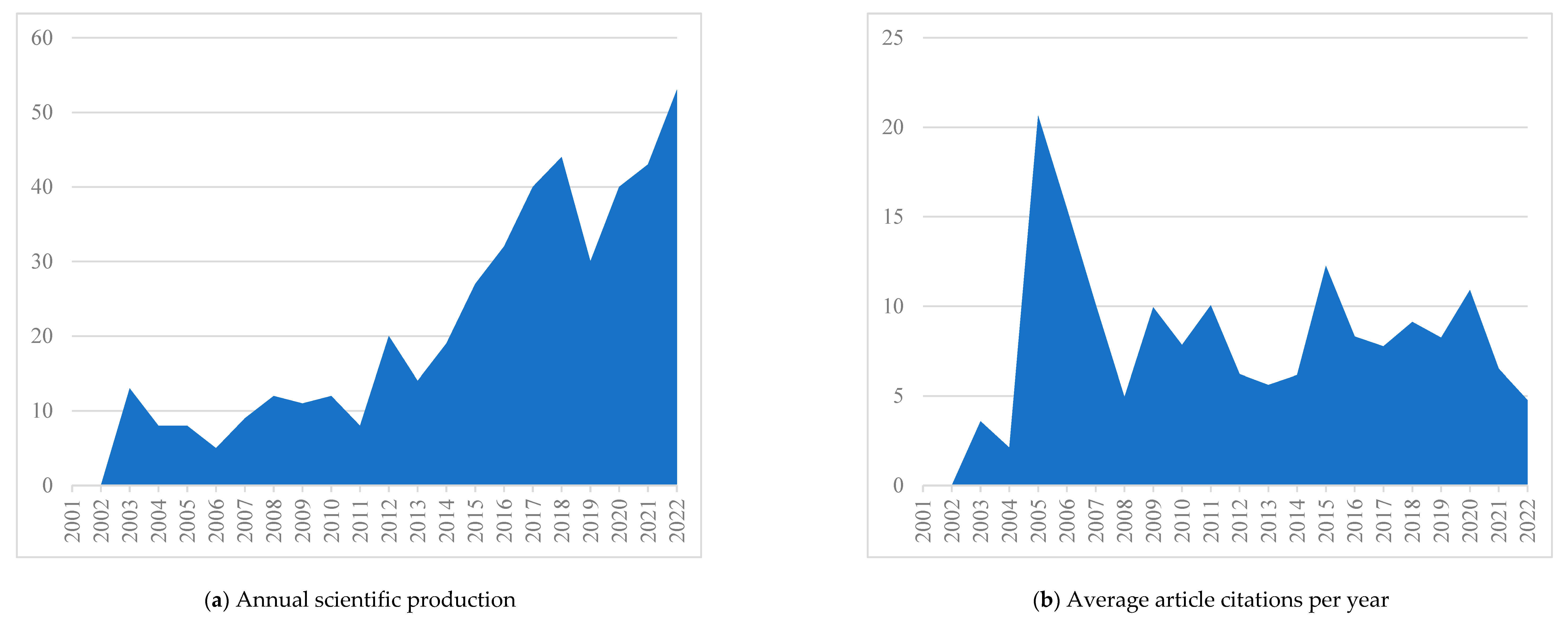

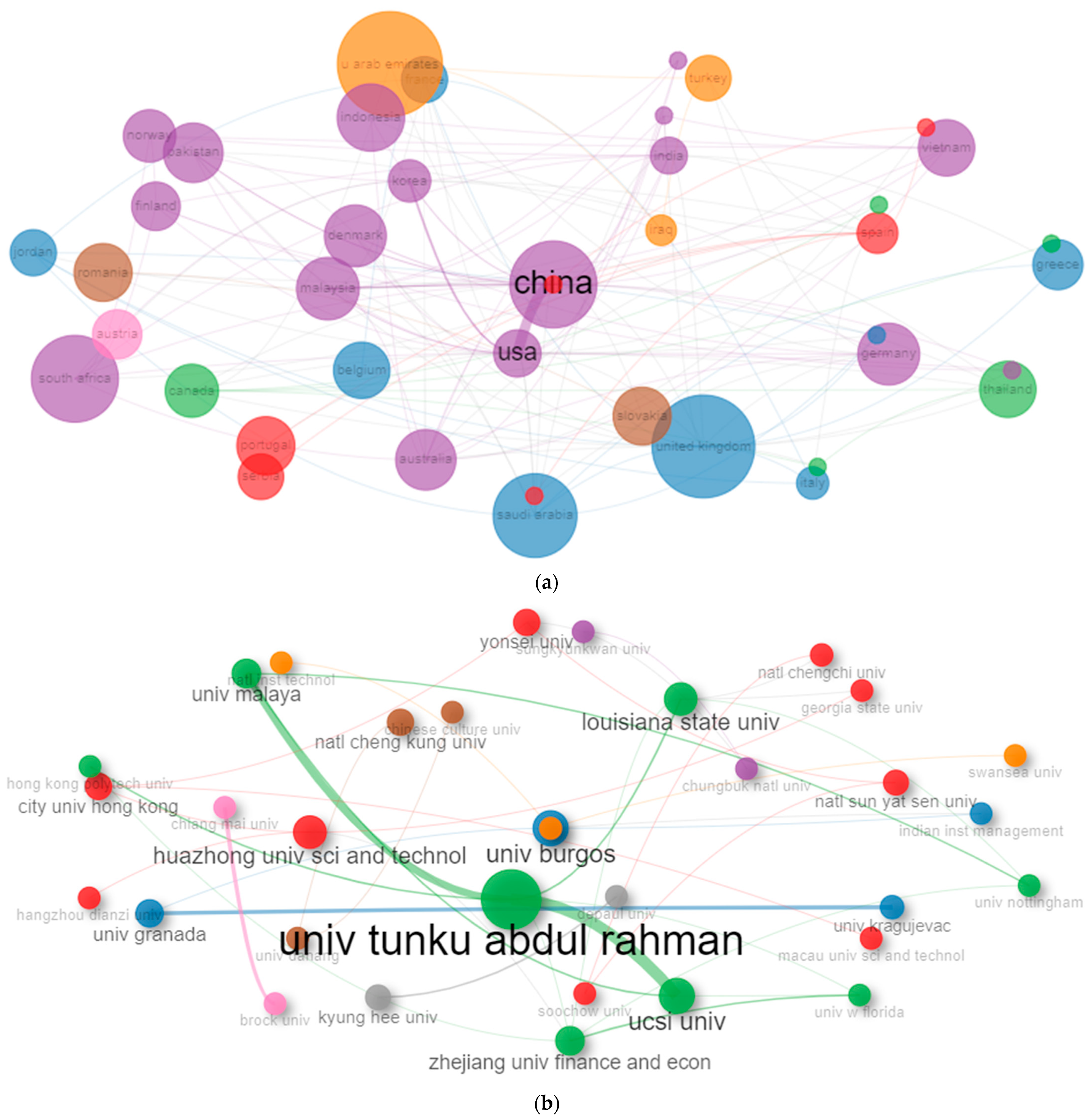
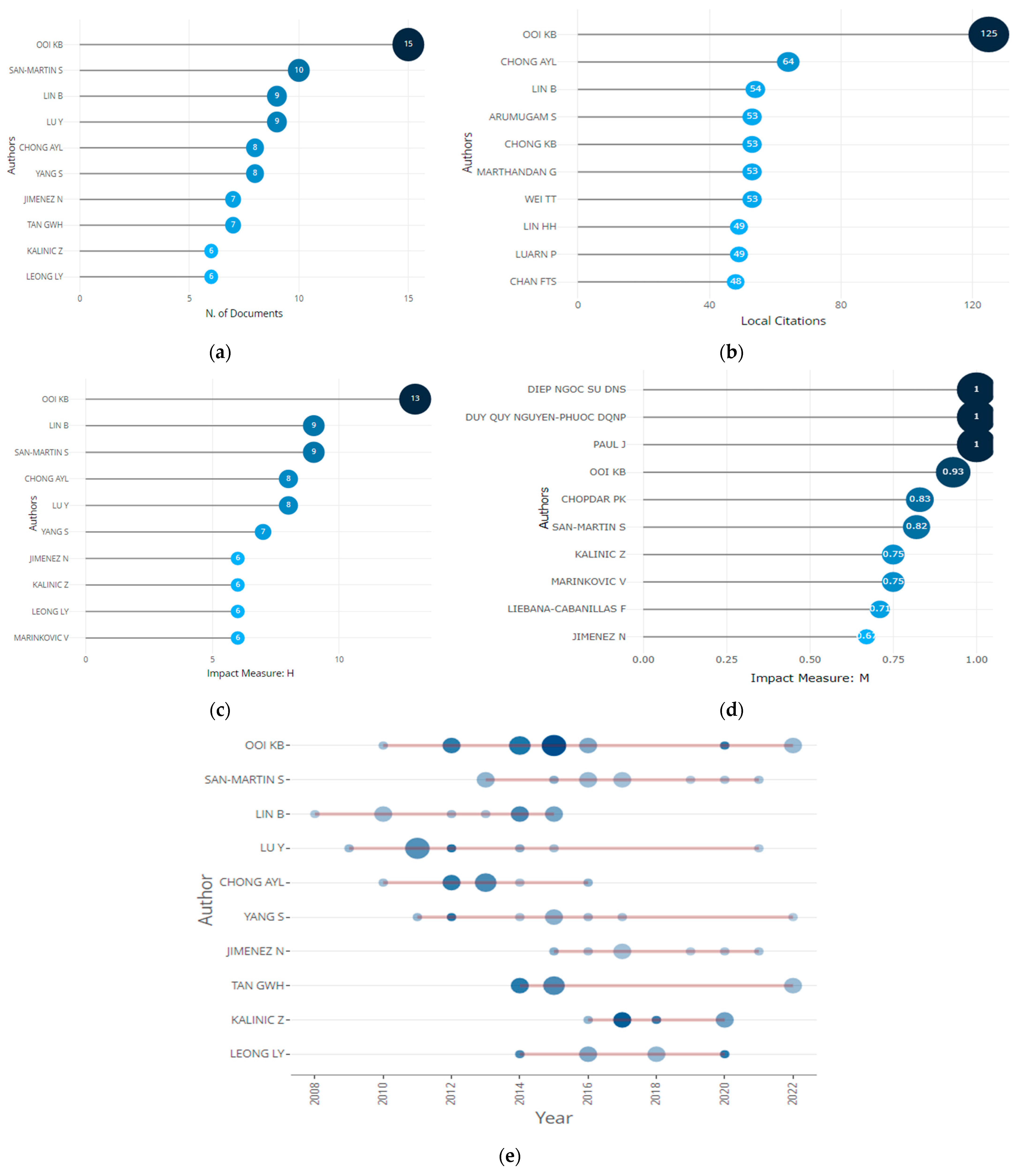
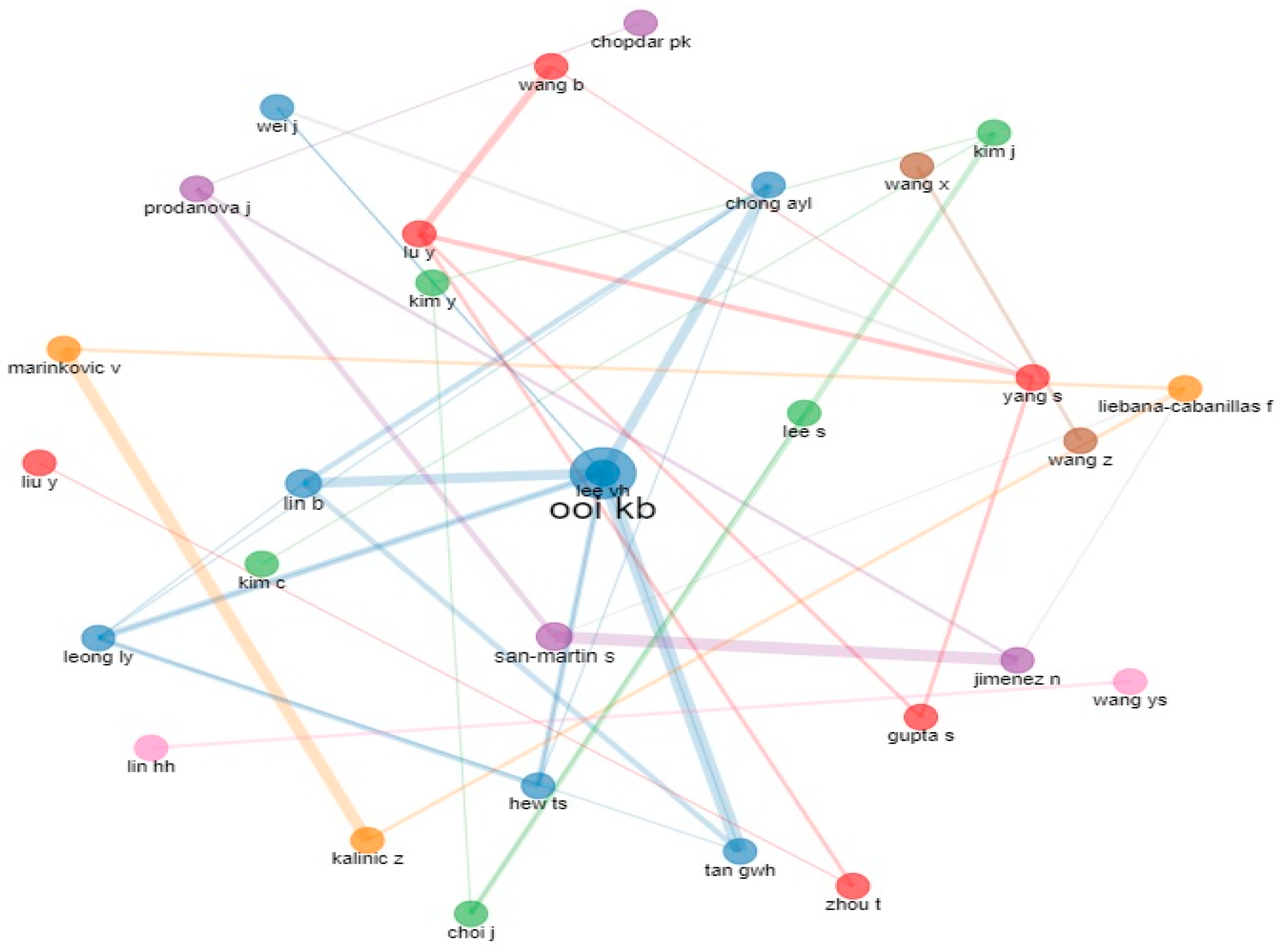
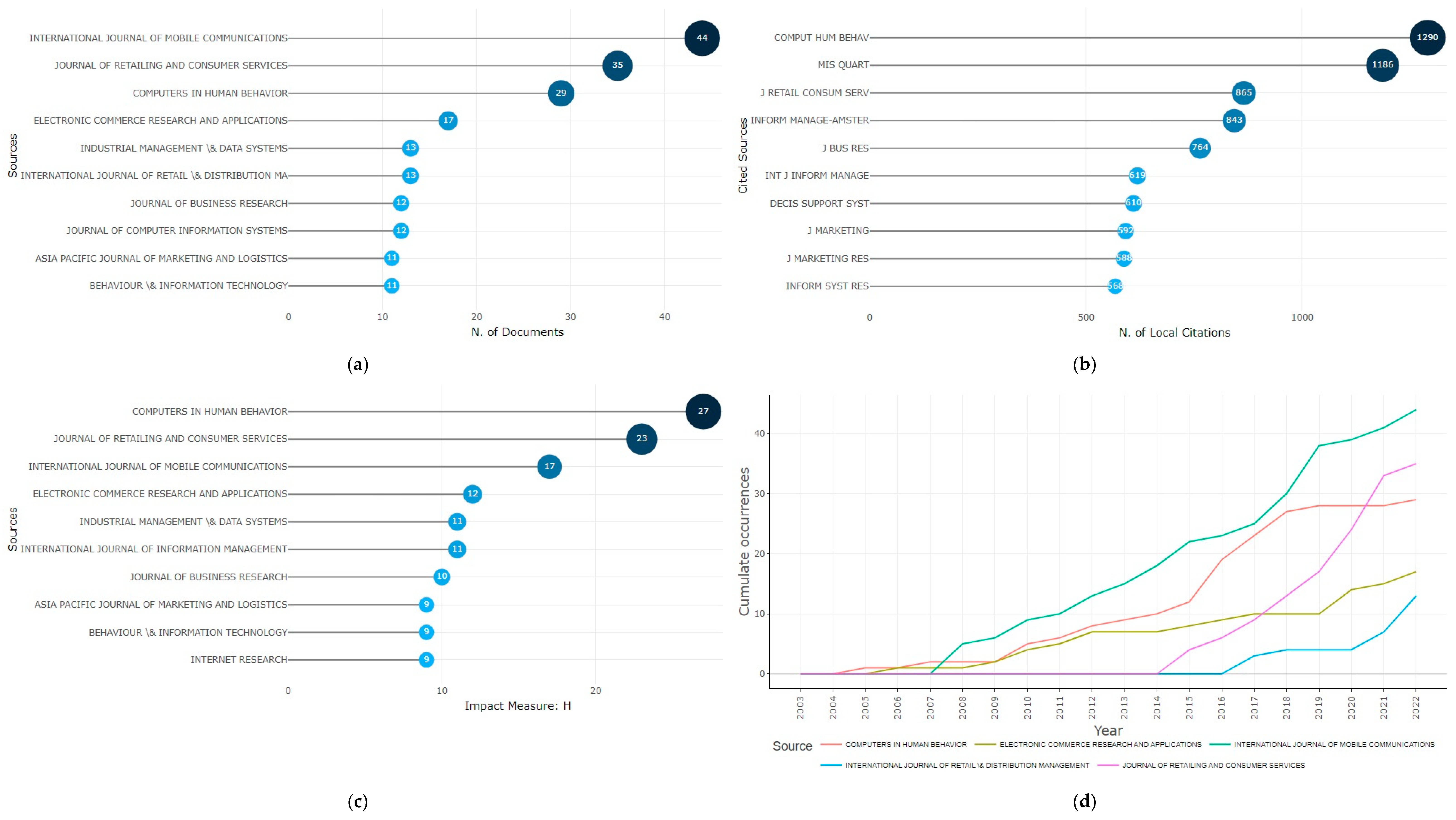
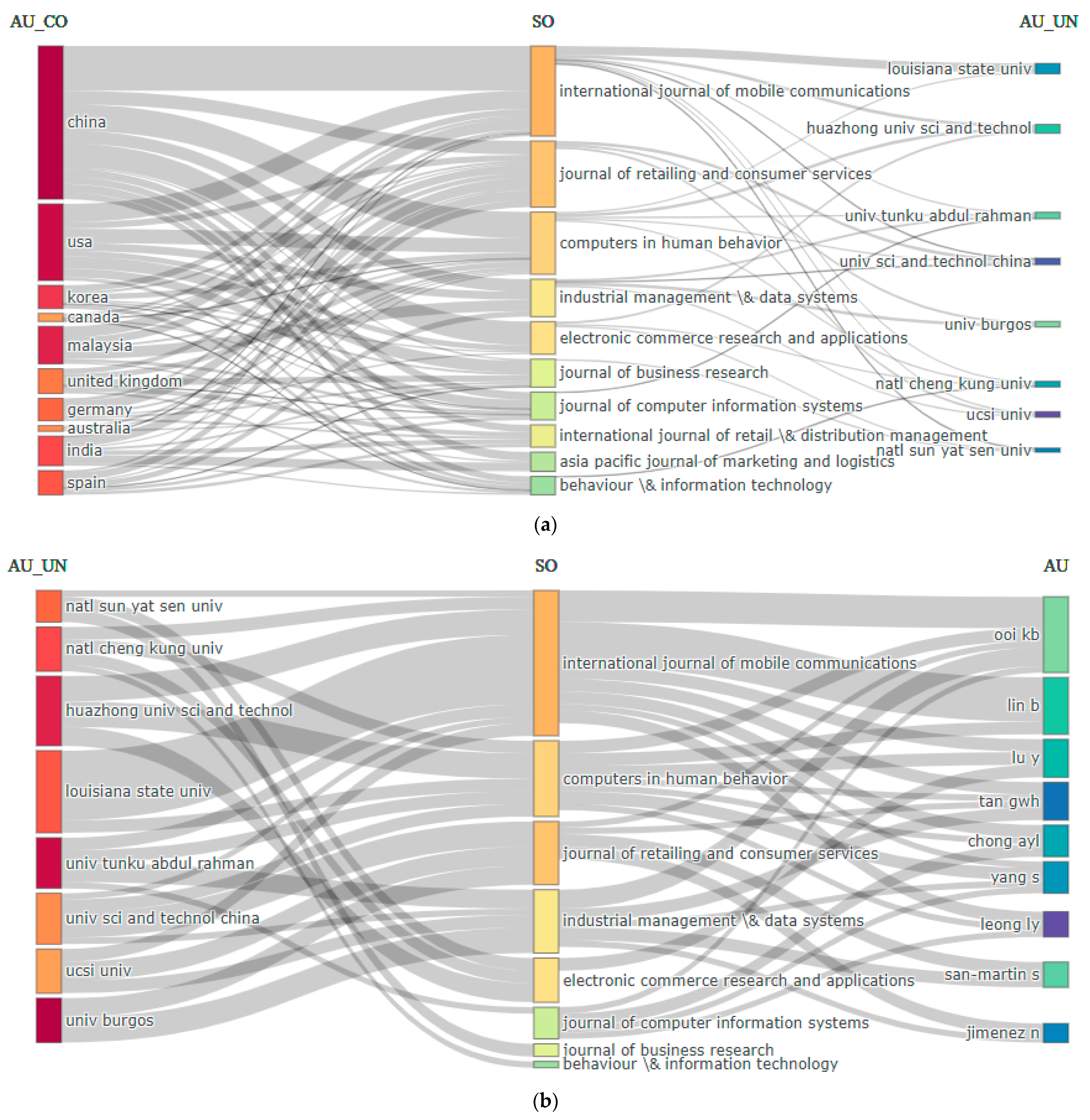


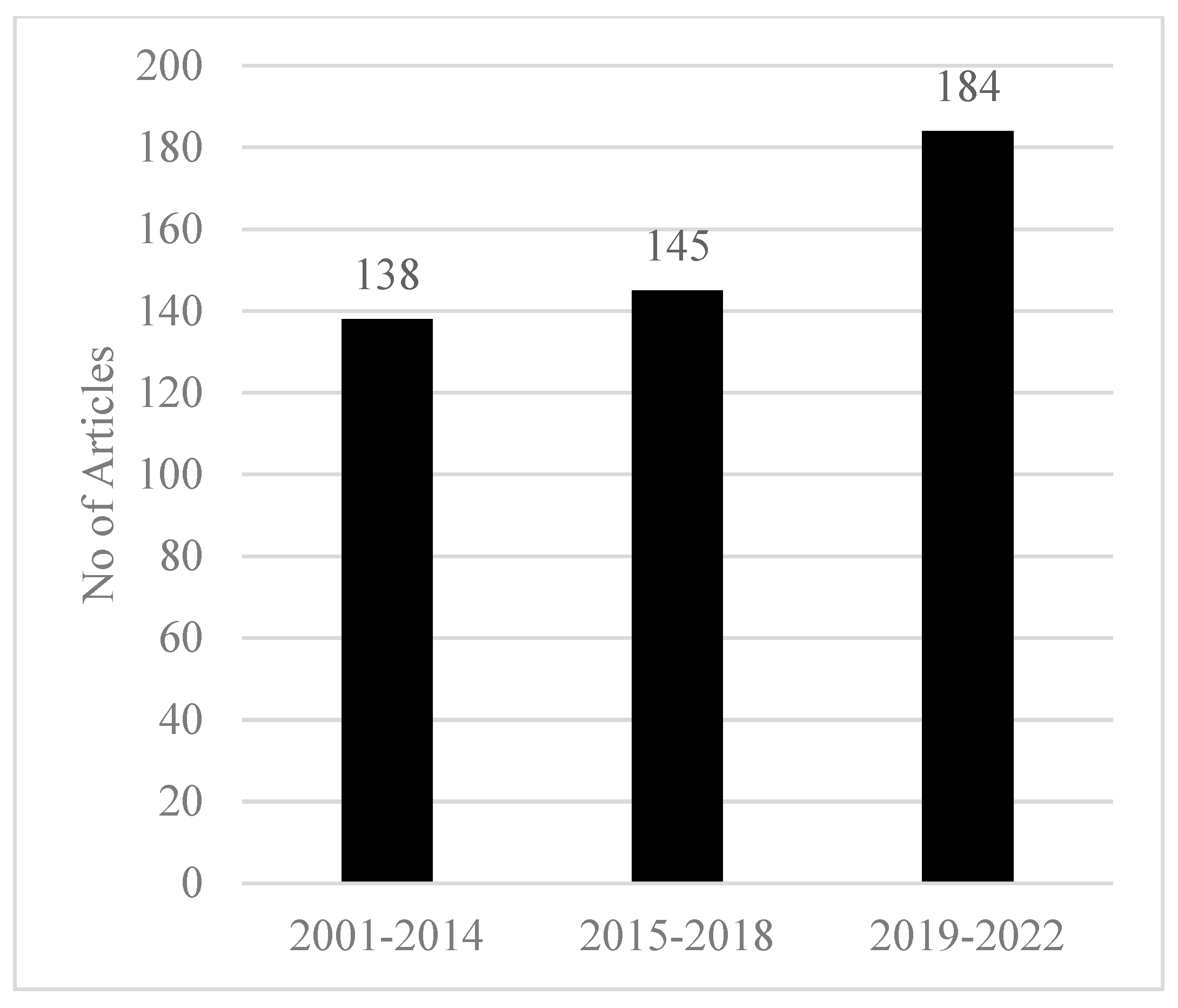
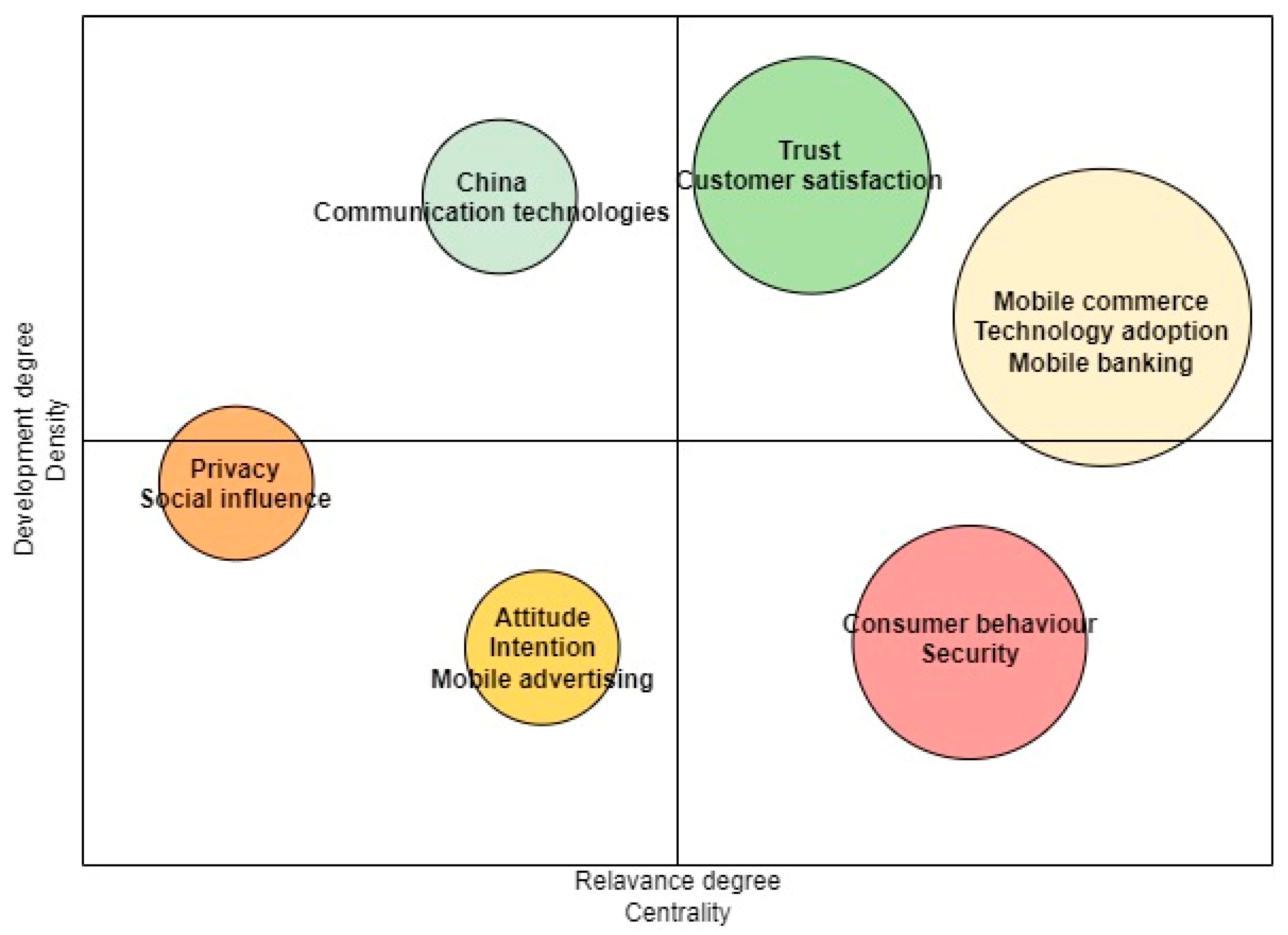

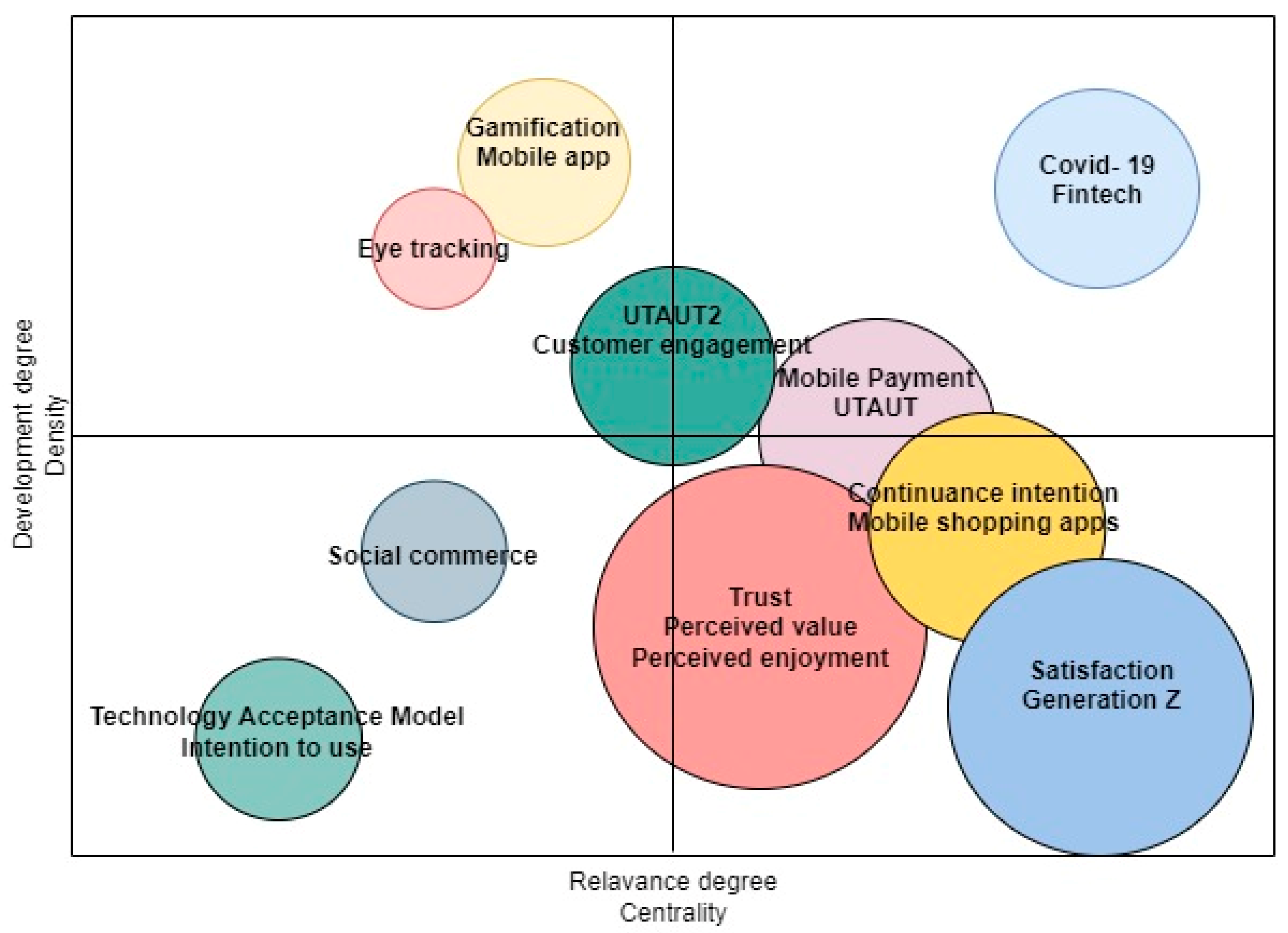
| Step 1. Scope of investigation A bibliometric analysis of m-commerce consumer research from 2001 to 2022 | ||
| Step 2. Data base selection Web of Science (WoS) | ||
| Step 3. Documents selection First selection criteria TITLE-ABSTRACT-KEYWORD PLUS TS = (“m-commerce” or “mobile commerce” or “m-shopping” or “mobile shopping”) AND TS = (“antecedent” or “determinant” or “adoption” or “acceptance” or “intention” or “involvement” or “purchase” or “continuance” or “behavior” or “risk” or “trust” or “choice” or “satisfaction” or “loyalty”) (Resulted in 934 documents) |  | Documents Selection |
| Second selection criteria TIME INTERVAL 2001–2022 (Resulted in 932 documents) | ||
| Third selection criteria CATEGORY OF DOCUMENTS “Research Article” (Resulted in 882 documents) | ||
| Fourth selection criteria WEB OF SCIENCE CATEGORIES Business, “Computer Science Information Systems”, Management, Telecommunications, “Computer Science Interdisciplinary Applications”, Information Science Library Science, Communication, Psychology Multidisciplinary, Psychology Experimental, “Computer Science Theory Methods”, Computer Science Cybernetics, Social Science Interdisciplinary, Economics, Psychology Applied, Multidisciplinary Sciences, Psychology Social, and Social Issues (Resulted in 761 documents) | ||
| Fifth selection criteria INDEXED IN SSCI, SCIE, ESCI, & AHCI (Resulted in 761 documents) | ||
| Sixth selection criteria PRUNING AND SKIMMING OF DOCUMENTS 2001–2022 (Resulted in 467 documents) | ||
| Step 4. Processing of Selected Documents RSTUDIO’S BIBLIOSHINY |  | Bibliometric Analysis |
| Step 5. Analysis and Inference of Results |
| Ranking | Title | Author(s) | Journal | Year | TC | AC/Y |
|---|---|---|---|---|---|---|
| 1 | “What drives mobile commerce?: An empirical evaluation of the revised technology acceptance model” | Wu and Wang [32] | Information & Management | 2005 | 1185 | 65.83 |
| 2 | “Value-based adoption of mobile internet: an empirical investigation” | Kim, Chan, and Gupta [29] | Decision Support Systems | 2007 | 853 | 53.31 |
| 3 | “Toward an understanding of the behavioral intention to use mobile banking” | Luarn and Lin [45] | Computers in Human Behavior | 2005 | 819 | 45.50 |
| 4 | “An empirical examination of factors influencing the intention to use mobile payment” | Kim, Mirusmonov, and Lee [3] | Computers in Human Behavior | 2010 | 533 | 41.00 |
| 5 | “Explaining consumer acceptance of handheld Internet devices” | Bruner II and Kumar [46] | Journal of Business Research | 2005 | 505 | 28.05 |
| 6 | “An examination of the determinants of customer loyalty in mobile commerce contexts” | Lin and Wang [30] | Information & Management | 2006 | 460 | 27.05 |
| 7 | “An empirical investigation of mobile banking adoption: The effect of innovation attributes and knowledge-based trust” | Lin [47] | International Journal of Information Management | 2011 | 419 | 3.91 |
| 8 | “Design aesthetics leading to m-loyalty in mobile commerce” | Cyr, Head, and Ivanov [48] | Information & Management | 2006 | 389 | 22.88 |
| 9 | “An updated and streamlined technology readiness index: TRI 2.0.” | Parasuraman and Colby [49] | Journal of Service Research | 2015 | 383 | 47.87 |
| 10 | “Understanding dynamics between initial trust and usage intentions of mobile banking” | Kim, Shin, and Lee [50] | Information Systems Journal | 2009 | 371 | 26.5 |
Disclaimer/Publisher’s Note: The statements, opinions and data contained in all publications are solely those of the individual author(s) and contributor(s) and not of MDPI and/or the editor(s). MDPI and/or the editor(s) disclaim responsibility for any injury to people or property resulting from any ideas, methods, instructions or products referred to in the content. |
© 2023 by the authors. Licensee MDPI, Basel, Switzerland. This article is an open access article distributed under the terms and conditions of the Creative Commons Attribution (CC BY) license (https://creativecommons.org/licenses/by/4.0/).
Share and Cite
Thangavel, P.; Chandra, B. Two Decades of M-Commerce Consumer Research: A Bibliometric Analysis Using R Biblioshiny. Sustainability 2023, 15, 11835. https://doi.org/10.3390/su151511835
Thangavel P, Chandra B. Two Decades of M-Commerce Consumer Research: A Bibliometric Analysis Using R Biblioshiny. Sustainability. 2023; 15(15):11835. https://doi.org/10.3390/su151511835
Chicago/Turabian StyleThangavel, Packiaraj, and Bibhas Chandra. 2023. "Two Decades of M-Commerce Consumer Research: A Bibliometric Analysis Using R Biblioshiny" Sustainability 15, no. 15: 11835. https://doi.org/10.3390/su151511835






